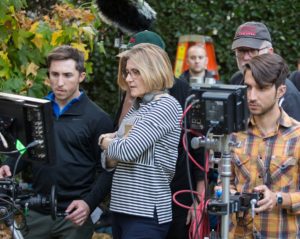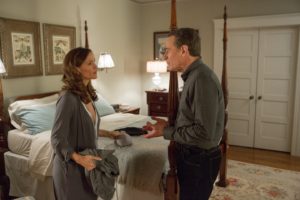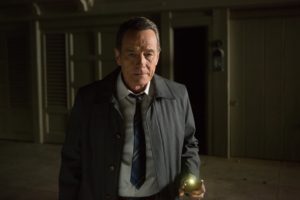
Robin Swicord is most known for her works as the writer for The Curious Case of Benjamin Button, The Jane Austen Book Club, Memoirs of a Geisha, Matilda, and Little Women. Swicord most recently wrote and directed the feature film Wakefield, an adaptation of E.L. Doctorow‘s short story starring Bryan Cranston and Jennifer Garner. The film premiered at the Toronto International Film Festival, shortly after premiering at Telluride.
Swicord has been intrigued by the works of E.L. Doctorow for some time now.
“I’ve loved E.L. Doctorow’s writing since I read his first novels in my twenties: Hard Times and The Book of Daniel, then Ragtime. Doctorow seems to saunter around inside America’s history, reaching into distant decades and pulling forward what feels like a modern story. His characters hook me, always. They’re instantly knowable, and as contemporary as I am– they just happen to live in this other time,” said Swicord.
After reading the Wakefield short story in 2008, the director contemplated possibilities of the story coming to the screen, not as a TV series, but rather an independent film. Although there was heavy interest in the story, the author of the short story wasn’t pursued immediately; not until 2011-2012 that Swicord approached Doctorow due to strong feelings about this project. Swicord believes E.L. Doctorow could have written a novel with the Wakefield short story. The first screenplay was completed in 2012, and then a year and half later it was put in the hands of Breaking Bad lead, Bryan Cranston.
Swicord continued “We wanted Bryan, but didn’t know if he had the star power of a movie actor to help get financing which is all based on foreign sales because Breaking Bad wasn’t in Europe or Japan at the time. Since that was the case, we had to wait a little to make the film, so I had to go back to Doctorow a few times. With all that, [I] knew Bryan was the right person from the start. I had Bryan in mind from an early draft of the script. The two major concerns were the financing and finding an actor that can pull this off. The performance and risk level is high as they are willing to go through all kinds of stuff, especially on an indie budget.”

Many challenges arise when adapting a short story to screenplay format. One wants to be faithful to the story, but simultaneously wants to create their own story. As one converts the story to screenplay format; problems will always appear, but solutions will always arise. Swicord explained that the biggest obstacle dealt was with the voice over narration,
“The voice over was complicated as who is he telling the story to, which point in the future is he telling the story, and why is he telling it? During writing, I got stuck on these problems of where the source of the voice over is and how it affects what tense he is speaking. Is he speaking in past tense or is he narrating as it’s happening right now? The voice over topic was a technical issue that could only be resolved by making the movie. I had Bryan record voice over at the beginning of production, towards the very end of production, in post-production, a 4th pass through, and then tweaking doing spot ADR for patches rephrasing a few lines. There was a lot of play in trying and sometimes I had the lines said in both tenses because I couldn’t decide how it should sound.”
The film ended up using the voice over in the beginning, as if he’s talking about it like it happened yesterday. The critical turning point in the story is when Cranston decides he’s not going to come back; that’s when the voice over switches over to the present. The director wanted us to be with Cranston side by side as he is going through the live events happening in real time. She didn’t want the audience to have a sense that he could survive. That’s when the voice over had to switch to the present tense to increase the stakes– a discovery found in the editing process.
“The most challenging aspect of the film was creating something like this in 20 days. I always knew it was going to be somewhere between 15-25 days. Fifteen days seemed impossible and 25 seemed like a luxury. We had very little money and little time. The crew was passionate and the fact that enough people got together to make this film was exciting. Every person came through in such an incredible way to make the impossible possible. Getting to do something so hard with people that are on top of their craft; it’s rare to see that happen and get to do something that is so strange, but profound and genuine,” said Swicord
The film has quite a bit of Bryan talking to himself throughout the movie. Ample amount of dialogue was written into the screenplay, but some if it was improvised as Cranston is very much a lively actor. Swicord mentioned that Cranston would randomly throw in a line and sometimes it was genius. Since Cranston had no one to talk to, no other choice than to talk out loud. Unlike in a novel, it’s impossible for audiences to know the inner thoughts of a character in a movie, unless they are expressed. The audience can get a sense of the emotional state, but not a specific thought happening. To get the audience to know the character’s thoughts, the character must express them to someone in some way.
“To combat this, the character is usually given a best friend, dog, writing letters, have a dairy, or some sort of device. If Bryan didn’t have anyone to talk to in the attic, he would have to talk to the audience in voice over. Then it’s just a question of how much he talks. Questions to consider… Do we need to be led by the hand? Do we need more voice over at the beginning and then just diminish towards the end? By the time act three rolled around, [I] found out voice over wasn’t needed as much.”
Jennifer Garner also had a ton of dialogue, we just don’t get to hear it.

“All [of] Jennifer’s dialogue inside the house is known as the shadow script, as if it’s like its own little movie in which things happened on certain days as conflicts arose, things were resolved, and decisions were made,” said Swicord. “Her character was an active character living a real life, as he’s watching her live. Sometimes what was happening in the house with Jennifer was at odds with what Bryan was imagining and happening. Jennifer was a very generous [actress] as she is behind glass for most of the film and at a distance. Jennifer liked the freedom that she wasn’t under pressure to hit a certain mark, being in the right type of light, blocking concerns, or thinking about continuity issues. Jennifer and her daughters created a real family, had their own world, own relationships, character arcs, and relationship arcs. Jennifer and the girls made it easy on me to direct as they were just at play. Sometimes [I] gave specific suggestions, but the actors were free to adjust how they felt was right for the scene.
“I love the way he works. He works very deeply from text, he wants to understand every single moment on the page, and he has ideas as he does it, and part of his ideas are a way of finding out how porous is this, how much of a moment can I make this, is this a meal or is this a line I just toss off. There’s a way he’s trying, playing, and throwing stuff in. I didn’t try to censor Bryan, just gave him that time to play and let him go. Bryan has this sense of play and animation that is beautiful to witness,” Swicord said of Cranston.
On set, Swicord would let takes run, allowing Cranston to reset and try various approaches. Trust on the director’s part allowed Cranston to bring his understanding of the scene, or sometimes she was there to remind him about when a specific shift in the character will happen. Swicord gave the actors freedom and let them run with it. The director rarely stepped in during a performance, but when she needed to jump in, she tried to targe the truthful sense of the scene.

Garner was also immensely thorough and tremendously prepared even to the tiniest of details. “She was very prepared and had every word memorized, even the lines that weren’t going to be heard by the audience. Jennifer’s lines were all recorded incase they were going to be overlapped in the sound mix to overhear elements of her dialogue. Even though Jennifer didn’t have to be spot on with the words, she was. To keep the scene fresh, tried it different ways through blocking and letting the actors go during the 2nd and 3rd takes. The process made it easy to direct both Bryan and Jennifer.”
Wakefield emphasized theme, more than a certain message. Swicord explained some of the strong thematic elements in the film. She believes it is an intricate film with many themes that cannot be summed up in one idea. “The journey of person, do you really have to leave yourself in order to change? Did he have to abandon everything or could he have stayed in one place and become more the man he wanted to be? He has to go through an emptying of an old self, a self he would like to discard in order to begin again. We don’t know what will happen when he begins again. He had to do the work of emptying first, before he can discover who he was. The emptying dealt with shedding of certain role playing and game playing; and received ideas that he nurtured in private about his wife, being a victim in the world, and how unappreciative he was, rid himself of inner monologues, see himself stripped bare, and understand what it was just to be the naked human before he could come back to himself. The theme began as we are all like this, we all have some desire to escape, and a certain desire to return home. These are in contrast with one another. The theme ended up being about something about becoming.”
Wakefield opened in New York City on May 19, 2017. It is set to release in Los Angeles and additional markets, including VOD on May 26, 2017. Wakefield is the 2nd feature film directed by Robin Swicord.





